A Botanical Miscellany? Digitising the Directors' Correspondence
Directors' Correspondence digitiser, Kat Harrington looks at letters to Kew's first official Director, Sir William Jackson Hooker, sent from Brazil. The first is from Maria Graham (in later life, Maria, Lady Callcott) who became one of the leading female travel writers of the early 19th century.

The Directors' Correspondence (DC) team is currently digitising four volumes of letters mysteriously labelled as 'miscellaneous' volumes.
These volumes contain just over a thousand pieces of correspondence to Kew's first official Director, Sir William Jackson Hooker (1785-1865). Working on this collection has been particularly fun thanks to a historical quirk of its arrangement - one minute we're in Sydney, the next, Egypt.
In this two-part post I wanted to highlight just two letters from two authors, both based in Brazil, whose lively descriptive style captures their experiences of living and travelling in South America. Hopefully they will inspire you to further investigate Kew's rich archival resources.
Maria Graham and her Rio idyll
On 30 Jan 1825, Maria Graham writes to Hooker from Laranjeiras, a neighbourhood in Rio de Janeiro, Brazil, reporting that her engagement "in the palace" is over and she is uncertain how long she will remain. She will do her best regarding seeds and plants for Hooker, who was gathering interesting specimens for his first major publication, Exotic Flora (1822-1827). Following the untimely death of her Naval officer husband on a voyage from England to Chile, Graham had determined to remain in Chile and travelled to Brazil where she was engaged by the Emperor as a tutor for his daughter Princess Maria da Gloria, later Queen of Portugal and the Algarves. Graham's appointment did not last long; perhaps the courtiers feared that she wished to Anglicize the Princess.
In her letter Graham focuses on botanical matters such as the various difficulties of drying plants in Rio; the abundance of fleshy vegetation which does not press well, the unsuitable climate, mould, and insects. She does however meet with some success and by the Aurora has sent Hooker 22 fern varieties all growing between her cottage and the top of the Corcovado (where Christ the Redeemer now stands). Where she cannot dry a plant she draws it very carefully.

A tree for ship masts
A stone's throw from her cottage Graham reports the largest tree near Rio, which the native people call 'Jiquitibà' (possibly Cariniana legalis). This species is preferred to all others there for ship masts as it grows so upright and tall. Graham cannot see that any botanist has seen or described it and provides Hooker with a sketch of a branch and various parts of the flower, noting its delicious evening scent which perfumes the whole valley.
Graham's time in Rio does not pass without incidence...
...The other day a thunderstorm floated my parlour - & for three days my mountain torrent[?] was so high I had no communication with the rest of the world.- However I will make you envious: in the first place my cottage is known by its Tree the Crataeva or garlic pear, the largest & finest I ever saw - it has not blossomed since I came though. Then the hedge, besides coffee, cotton, Bombax pentandrum, castor oil nut & limes, is very gay with Bauhinia the large white, which blows at sunrise & falls by ten o'clock – with blue Convolvulus - & things that ought to have a distinguishing name... & half a dozen kinds of Cactus as grotesque as possible, & the ferns & grasses all curious & different from our own. Then such butterflies & grasshoppers and creatures of all sorts & the little humming birds playing about.
Extract from letter (Archive ref: DC 43 f. 49)
Graham developed a fascinating career publishing her travel journals, editing works such as account of George Anson Byron's voyage on the HMS Blonde to the Sandwich Islands, and writing extensively in the fields of popular science, history and art history. Graham's correspondence provides an exciting glimpse into the global network of correspondent's Kew established in its quest for new and useful plants. Her letters will shortly be added to the over 29,000 already digitised and made available to search online via the JSTOR Global Plants website.
In our next post we will focus on an intriguing piece of 'miscellaneous' correspondence from explorer and botanist Richard Spruce.
Graham and botany
Graham describes herself as botanically ignorant, however her letters and sketches certainly suggest otherwise. She also discusses using publications to improve her plant descriptions and recalls attending botanical lectures, including a charming one given by the Swiss botanist de Candolle on palms. Graham emphasises to Hooker that she will not be negligent in the search for plants and may be of use in exciting other people to be busy, a skill which Hooker was always eager to encourage.
Throughout the letter Graham's enthusiasm shines through...
I am very very fond of plants & scruple neither muddy feet nor torn clothes for their sake.
Archive ref: DC 43 f.49, image RBG Kew


